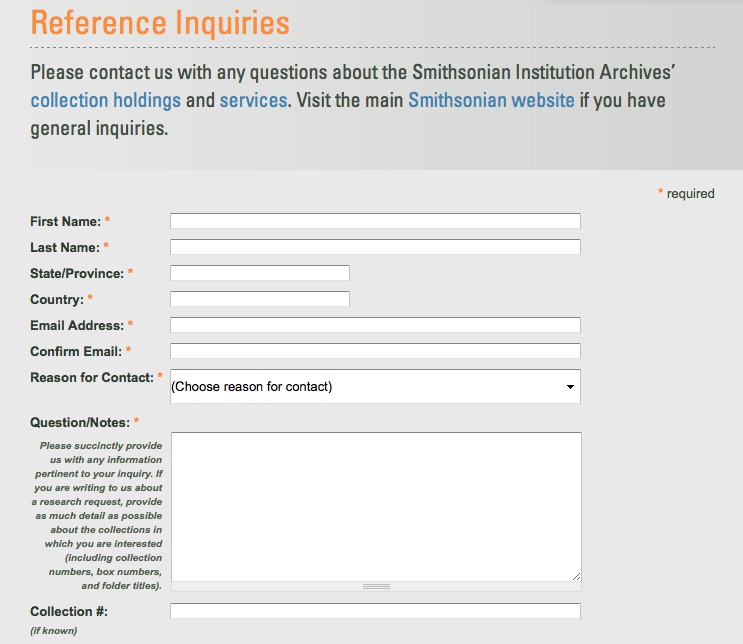Results for "Smithsonian Institution. Office of Information Resource Management. Collections Information Systems Division"

Museum Computer Network and the Smithsonian Institution: Support and Encouragement
- Date: April 18, 2017
- Description: In honor of the 50th anniversary of the Museum Computer Network, this second blog explores the early interactions of MCN with the Smithsonian.
- Blog Post
“Dependent upon the Kindness of Strangers”: Volunteers and the Smithsonian
- Date: April 10, 2012
- Creator: Pamela M. Henson
- Description: An overview of the contributions volunteers have made at the Archives and across the Smithsonian.
- Blog Post
Passwords and Paper Printouts: Preserving the Electronic Records of the Devra Kleiman Papers
- Date: July 28, 2011
- Description: In the course of my internship at the Smithsonian Archives’ Digital Services Division I’ve worked with myriad digital records, converting both new material and past accessions into formats that can be more easily preserved. But the most exciting part of my time here came when I was given my very own accession, the Devra G. Kleiman Papers, to work on. My task was to copy all of

Archiving Born-Digital Media from the Smithsonian Astrophysical Observatory
- Date: October 27, 2020
- Description: We’ve been processing audiovisual media collections from the Science Media Group division of the Smithsonian Astrophysical Observatory.

The History of Email at the Smithsonian
- Date: July 21, 2015
- Description: Many of us read, write and send emails every day, but when did it all start at the Smithsonian? In 1980 Smithsonian staff had typewriters and telephones on their desk, with one or two FAX machines per office. The Smithsonian operated a single general purpose computer, the Honeywell mainframe, for all Smithsonian data processing applications and which did not include an email

Some Archives Technologist Career Advice
- Date: May 24, 2018
- Creator: Effie Kapsalis
- Description: This is the latest post in our series on career advice for the aspiring archives professionals. Each edition features information and career advice from a different member of the Archives team, regarding what they do, how they got here, and how you can too. Check out our previous posts, and don’t be afraid to let us know who you would like to hear from next!The Archives has

Takin' Care of Records
- Date: April 17, 2018
- Creator: Heidi Stover
- Description: Did you know April is Records and Information Management Month? Did you also know that the Smithsonian Institution has over 154 million objects, 10 million digital records, and 156,830 cubic feet of archival materials in its collections? It is mostly thanks to amazing record keeping that we are able to locate, care, and give access to millions of fascinating objects.We look at

Many Hands Make Light Work in the Digitization Process
- Date: September 11, 2014
- Description: Digitizing collection material at the Smithsonian Institution Archives is a group effort involving interns, volunteers, and staff.

The Power of Collaboration
- Date: October 21, 2014
- Creator: Kira M. Sobers
- Description: Audiovisual archivists come together at the annual meeting of the Association of Moving Image Archivists to create tools for audiovisual conservation.

How Computers Took Off at the National Air and Space Museum: 1980-1981
- Date: December 1, 2016
- Description: A look at a survey of computer usage at the National Air and Space Museum in 1980.
- Blog Post
Research at the Archives: Finding Grasses for the South
- Date: May 26, 2011
- Description: As a postdoctoral fellow at the National Museum of American History, I’ve spent months in the Smithsonian Institution Archives researching a book tentatively titled, Not Naturally a Grass Country: Environment, Plant Genetics, and the Quest for Agricultural Modernization in the Humid World. It’s largely a story about global attempts to replace one form of agriculture—the

The Other Side of Mary Agnes Chase
- Date: March 19, 2015
- Description: Mary Agnes Chase is known for her extensive contributions to the study of grasses, but who was Mary Agnes Chase? Why is her private life so shrouded in mystery, and how can we find out more.
